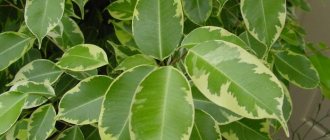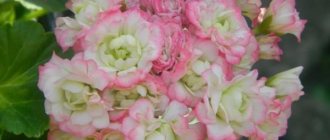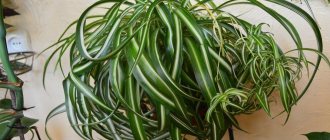Plants » Flowers
0
2322
Article rating
Kira Stoletova
Benjamin's ficuses are especially popular among gardeners. One of them - ficus Natasha (ficus natasja benjamina) - is an evergreen plant from the mulberry family, which is increasingly found on the windowsills of residential apartments, offices and other institutions. Ficus Natasha is extremely popular due to its unpretentiousness and beauty. There is something about this flower that makes a room feel cozy.
Ficus Benjamina Natasha
Many signs say that in a house where a ficus is located, people quarrel less, problems are solved, and ficuses also help couples with their energy to have a long-awaited child.
Ficuses are aliens from Asian countries, the Australian subtropics, China and the islands of Java and Ceylon; in nature they reach gigantic sizes: up to 10 m in length. Domesticated ficus trees are much more modest in size. For example, ficus Natasha is only 40 cm in height. The Natasha variety is formed into a compact bush, the branches of which can be connected in several pieces to make a neat bonsai-type plant.
Description of the plant
Many gardeners plant such a ficus specifically for the art of bonsai, so the small growth of the flower will be a plus. The color of this variety is varied: from dark green to green with light splashes, leaves are 3 and 1.5 cm in size, slightly shiny. Ficuses of this kind do not require too much painstaking care, but in order to achieve a beautiful crown of the bush, you need to follow the care recommendations: water the plant on time and correctly, feed it.
Caring for such a flower at home is not difficult, and if all the rules are followed, even a beginner can grow such a plant. Ficus benjamina variety Natasha is suitable for making various compositions along with other flowers. Before purchasing, you need to learn how to care for the ficus variety Natasha so that the plant enjoys active growth. You can see what ficus Natasha looks like in a photo or video.
Lighting and temperature for ficus Natasha
Ficus Natasha does not really like to move from place to place - it is better to determine a permanent place of residence for him in advance. Such a place should not be located near heating systems or in a draft; the temperature should not fall below 13°C or rise above 28°C. If the ficus doesn’t like the conditions, it can easily shed its leaves. It is best to place the ficus near the window.
If the ficus suddenly drops its leaves, there is no need to worry: the plant will adapt and grow new foliage if you take care of it. It is very useful to shake the leaves and spray with settled water at room temperature - this will help to form a lush crown. Ficus even in miniature looks like a real tree.
Watering the plants and fertilizing
It is better to water Ficus Benjamin Natasha in several stages so that the soil in the pot gets wet evenly. The water must be left standing for at least a day, at room temperature. The flower does not tolerate dry soil, but excessive watering is contraindicated. After watering, do not forget to empty the water from the pan: if left, the roots may rot. If the leaves turn yellow and fall off after purchase, this may be a reaction to improper watering or a change in regime. In this case, you need to adapt the ficus at home, and also adjust the watering regime.
If the Natasha variety sheds its leaves and the problem is not watering, the lighting may be incorrect. You can learn more about caring for ficus Natasha in the photo or video.
How can you feed ficus? The plant's winter season is a dormant period, so there is no need to fertilize it at this time. But the rest of the time, the ficus needs to be fed monthly. When choosing a mineral fertilizer, you must carefully read the instructions; the dosage must be followed exactly, otherwise the flower may get sick. Nitrogen fertilizers contribute to the growth of a lush crown. It is better to alternate mineral and organic fertilizers rather than apply them together; excess fertilizers can lead to fungal diseases.
Superstitions and signs
There are many signs and superstitions associated with ficus.
Among all nations, Benjamin is considered a carrier of exclusively positive energy. It cleanses the home of negativity and puts the mental and emotional state of the residents in order.
Residents of Thailand revere the tree as sacred and believe that it brings good luck in any endeavor.
The Natasha variety is able to eliminate the feeling of chronic fatigue, give confidence, and change the worldview in a positive direction.
A plant in a green pot improves your financial situation if you bury a couple of coins in the soil.
The flower is often bought by married couples, because it makes the relationship between spouses strong, sincere, and contributes to replenishment of the family.
Ficus benjamina transplant
It is not recommended to replant the flower immediately after purchase. After purchasing a ficus Benj, it will take about 2 weeks for it to adapt at home to a new place. Therefore, the ficus Natasha transplant should be done no earlier than after 2 weeks, or even a month. Transplantation is carried out from the beginning of April to the end of August. Young plants need to be replanted every year, and adults - once every 3-4 years.
A sure sign that the time has come for replanting is more frequent drying out of the soil, indicating that the roots are cramped in the pot. When starting to replant, you need to take a new pot 3-4 cm larger than the previous one in width and height. You should definitely put a good drainage layer on the bottom, and pour a special mixture for ficus with humus, sand and peat on top. Next, you need to carefully remove the flower from the old pot along with the earthen ball, without damaging the roots, and replant it in a new place. Along the edges of the pot, between the walls of the container, you need to add a little soil and carefully compact it.
Plant propagation
Ficus Natasha can be propagated in the spring. It is best to propagate from cuttings that have 3-4 buds. You can root it in water or plant it in the soil right away, but you need to create a greenhouse effect. You can use a special means for the formation of roots such as “Kornevin”. To do this, the cuttings should be “powdered” with a composition for the formation of roots or placed in a solution (if the instructions for the preparation say so) and planted in moist nutrient soil.
While the cutting is forming roots, it should be covered with a transparent film on top. The plant must be in this greenhouse until roots form. We must not forget to maintain moisture without flooding the soil. As soon as the first roots appear, the ficus can be planted in a permanent pot.
Ficus pruning
Pruning is important for the formation of the correct crown of the tree. You can also use it to restore a dried flower at home and get active growth. If this is not done, the branches will stretch in length and weaken, and this will greatly affect the health and appearance of the plant. Pruning is carried out in February, as soon as the flower begins to “wake up” and the first rudiments of leaves appear. Cut off all long and weak branches. Ficus benjamina is a fast-growing plant, so pruning should be done in the next year after purchase.
It is best to prune young shoots. The longer the branch, the shorter it needs to be cut. There is no need to be afraid to trim the tops: such pruning will only make the bush more luxuriant and lateral buds will form. The cut is made above the bud using pruning shears or garden shears, on thick shoots at an angle, and on thin shoots - straight. If the branches of the bush are damaged by pests, they must also be removed. The cut must be treated with a garden varnish to avoid ficus diseases. If you get milky sap on your hands when pruning, be sure to wash it off with soap and water.
Description of the variety and photo
Ficus Benjamin Natasha was brought from the tropical parts of North and East Africa, as well as East Asia and Australia. It is kept in apartments, gardens, public places.
Has a lot of features:
- a system of roots that grows so much that they protrude from under the ground;
- rounded trunk of a light brown hue;
- branches and shoots are usually branched and drooping;
- The leaves have sharp tips and a smooth surface.
Properties and benefits
Ficus Natali is a common folk remedy. Tinctures, ointments and compresses are made from it. The plant helps with gynecological diseases, arthritis and radiculitis. It is believed that during epidemics it helps to destroy pathogenic bacteria.
Important! Before using ficus for medicinal purposes, you should definitely consult a doctor.
The biological form of the species is a miniature tree 30-100 cm high with many small green leaves, reaching a length of no more than 3 cm and forming a lush crown. A voluminous and strong axial trunk, as a rule, is formed by several plant trunks planted in one pot and intertwined. The branched shoots of the tree are small but frequent, requiring systematic pruning and crown formation.
Ficus juice and pulp are used in both traditional and folk medicine. The plant helps in the treatment of certain diseases and pathologies:
- Tumors. Ficus Benjamin slows down the development of their cells and also protects against the appearance of other neoplasms.
- Stops inflammatory processes in mastopathy, thereby increasing the effectiveness of other medications.
- Lotions made from a decoction of roots and leaves normalize blood circulation and accelerate the recovery of bruised tissues.
- Improves liver function.
- A mixture of ficus juice and water helps eliminate headaches.
- Poultices made from the pulp of the leaves help relieve joint pain due to rheumatism.
- Ficus Natasha is also useful in everyday life: it effectively cleans the air of harmful substances, in particular benzene and phenols.
How to choose when purchasing
Inexperienced novice flower growers who want to purchase ficus “Natasha” are worried about making the wrong choice. First of all, you need to pay attention to the trunk, which should not have any signs of damage or fresh cuts . Leaves on the branches of a healthy plant are free of spots and dried areas ; pests should not be visible on them. It is important to choose a pot with dry soil.
The appearance of a ficus without signs of lethargy indicates its health. When purchasing, this serves as a guarantee of the right choice.
Pests and diseases
Most often, ficus plants suffer from leaf spot and root rot. These types of plants periodically turn yellow and shed their leaves. This is most likely due to an uncomfortable environment. The temperature may be too high or, conversely, low. This tropical plant needs high air humidity, so it is better to install an air humidifier next to the ficus or, in the hot season, constantly raise the humidity by spraying the bush.
Overmoistening the soil does not benefit the flower; this can cause the ficus to develop root rot. This disease should be treated only by pruning damaged roots and special antifungal drugs. If the fungus has covered the entire flower, the plant needs to be replanted. Ficus plants also need to be fed in moderation; too much fertilizer can lead to fungal diseases.
Common ficus pests
- Spider mite. Ficuses are most often damaged by it. If whitish spots on the leaves or thin cobwebs become noticeable, the plant is most likely infected. Affected leaves fall off after spider mite attacks. After identifying the problem, you must immediately begin treating the plant with a special preparation for spider mites. Excessive dry air contributes to the appearance of such a pest. It is best to keep and grow a flower on the east or west side. During periods of solar activity, the ficus should be removed from direct exposure to the sun. In winter, to prevent the leaves from drying out, you need to maintain air humidity at at least 50-70%. You can place wet expanded clay or moss next to the flower.
- Shield. This pest feeds on the sap from the leaves and trunk, leaving special secretions, which in turn contribute to the appearance of sooty fungus. This is dangerous because the growth of the plant slows down, the leaves turn yellow and fall off. You can get rid of such a pest only by treating the flower with a medicinal composition, which can be purchased at a specialized store, and getting rid of damaged shoots. As a preventive measure against scale insects, it is recommended to inspect the flower daily for the presence of pests. If insects are found, they must be removed.
- Mealybug. This is a very small white insect that feeds on the sap of the plant. They get rid of it in the same way as they get rid of scale insects. Mealybugs appear due to improper care or feeding schedule. If a mealybug appears on a flower, the ficus may be oversaturated with nitrogen. When there is an excess of nitrogen in the leaves, metabolism is disrupted and they become vulnerable to attack by pests. When the air is dry, pests can attack the flower even more actively, so you should not place the ficus near heating devices. As a preventative measure, it is recommended to immediately remove dried leaves, as they serve as breeding grounds for insects. Periodically, you should give the flower a warm shower; it will wash away any possible insects.
Disease Prevention
Problems with ficus appear due to non-compliance with maintenance conditions. You can prevent these troubles if you know what is harmful to the flower. This may be dry air in the apartment, excessive watering or drying out of the earthen coma, drafts, lack of sunlight, frequent moving of the pot, stagnant water in the pan, too frequent fertilizing. To avoid problems with care, you should study the description of Ficus Benjamin and the rules of care.
Home care
Ficuses require special attention. Therefore, it is worth considering the basic nuances of caring for this plant.
Watering
It is necessary to water the soil in a timely manner. In this case, you need to calculate the optimal time for watering. The following is required:
- air humidity,
- room temperature,
- plant size,
- season.
It is recommended to moisten the soil when it dries to a depth of 1 cm. Water should be used that is warm and settled. The chlorine contained in the water has a negative effect on the flower, burning the foliage. Watering should be thorough, removing excess liquid after 30 minutes.
You can give your ficus a shower by spraying it with a spray bottle. This will be a good addition. However, overwatering should be avoided.
Fertilizer
Outside of nature, ficus trees grow rather slowly. But fertilizing can speed up this process. For this, any water-soluble mixtures for palm trees are used. These include “Gumisol”, “Rainbow” and many others.
It is required to apply fertilizer in accordance with the instructions. Excessive introduction into the root system can destroy the plant. The following minerals need to be in sufficient quantities:
- phosphorus,
- potassium,
- phosphate,
- iron.
Important! Feeding occurs only during active growth (spring and summer), and during the dormant period (winter) the ficus does not need to be disturbed. During the growing season it is worth giving it minerals every 2-3 weeks. The first dose should be significantly less than in the instructions. This is necessary in order to study possible adverse reactions of the plant. If it feels great, then you can continue to use it.
Lighting
This plant needs a lot of light. Therefore, the pot should be on the south side. It is important that the windows are well lit, otherwise a crooked trunk may form.
Important! It is necessary to protect the plant from direct sunlight, otherwise the leaves will burn.
Temperature and humidity
Humidity and air levels are moderate. The plant tolerates short-term drought well, but if overwatered, it quickly dies. A grower has the opportunity to succeed in growing a healthy ficus if he maintains a humid climate in the room where the plant is located by installing a humidifier or misting his pet twice a day.
It is advisable to maintain the temperature at the same level all year round. Optimal level: + 23-25 degrees. Winter minimum temperature: +10 degrees, if below that the plant dies. It is worth noting that plants can suffer from fairly low temperatures.
Trimming
Ficus requires regular pruning. This will allow you to form the crown and skeletal branches, as well as remove small diseased areas of the bush. Which branches need to be trimmed:
- the lower ones that appear on the trunk,
- without side shoots.
- the upper ones, on which there are no leaves or few of them,
- dry,
- broken pieces of wood.
Pruning is required as the ficus grows, but at least 2 times a year.
It is recommended to form a crown in early spring, when the tree begins to grow rapidly. Pruning allows you to rejuvenate the shoots and remove everything unnecessary so that the ficus can concentrate on growing new branches and leaves.
Important! Pruning requires the use of pruning shears. Before use, it must be disinfected with alcohol or other alcohol-containing liquids.
The pruning rule is to remove everything unnecessary, leaving only 20 cm of the main shoots, each of which should have 5-7 leaves. Thick stems are cut at an angle. All sections must be treated with activated carbon.
Crown formation
You can make a real room decoration from a ficus if you know how to decorate the crown using proper pruning at home. Miniature ficuses are most often formed in the form of a ball, a multi-tiered trunk in the bonsai style, or in the form of some complex figures. It is best to start forming the crown of a tree while it is still young; older plants grow more slowly. Planned pruning for formation is carried out in early spring during the period when active growth begins. You can trim the ficus at another time if very elongated shoots appear; branches growing inside the bush, damaged and dry branches are also removed immediately. Ficuses are often “braided” with each other, connecting two, three or more plants into one to give a decorative look and make the crown more luxuriant.
If you have four young ficus trees that individually do not have very dense foliage and you want to combine them into one plant, you can try braiding them. To do this, you need to prepare a larger pot for them (all four root systems should fit in it), carefully remove the plants from the pots, remove a little of the old soil and fold them so that the trunks are as close to each other as possible. It is better to cut off any branches that get in the way. Then the plants are planted in a new container, adding soil along the edges and making sure to compact it.
It is necessary to compact it so that after watering the plant does not skew to the side or fall through in the pot. The trunks are wrapped with thread made of natural material or burlap ribbon, beautifully intertwined. Then the plant is pruned, forming a crown of the required shape. To give the plant a rounded shape, the side branches and tops are cut so that the crown is shaped like a ball. If pests suddenly appear on such a plant, you need to remember that between the trunks entwined with rope, they will multiply most of all, since optimal conditions for this have been created there. That is why we must not forget to carefully treat the rope itself with a medicinal preparation.
Solving possible problems during cultivation
The plant needs warmth, regular watering and timely feeding. If a ficus is not properly cared for, its foliage may turn yellow, and if not properly cared for, it will become ill and die.
Care errors
If the leaves fall off, it means the air is too dry and the plant lacks nutrients and moisture. If the edges of the leaf blades turn yellow, after which the tree sheds its leaves, it means the plant is suffering from waterlogging. Such problems will not arise if watering is organized correctly.
Pests
Ficus Natasha can be affected by insects. When pests are found, they are collected manually or sprayed with insecticides.
Shchitovka
These are small brownish insects with a shield on their back. Scale insects settle on the plant in colonies and feed on its sap. They are removed manually with a swab soaked in soapy water. Insecticides (Actellik) are used to control insects.
Spider mite
A tiny red insect that weaves a web on leaves and stems. It feeds on the sap of the plant; its vital activity is indicated by yellow spots on the leaves. You can get rid of ticks by spraying with a solution containing an acaricide (Kleschevit, Fitoverm).
Thrips
Oblong brown insects that live in the soil mixture and cause damage to the roots of the plant. Insecticides (Aktara, Fitoverm) save you from thrips. If pests are detected, it is advisable to replant the plant in fresh soil. Before transplanting, the new soil mixture must be disinfected or calcined in the oven (stove).
Mealybug
A tiny, hairy, white insect that settles on the plant in colonies. It feeds on the juice of leaves. Pests must be collected manually using a damp cotton swab. To combat insects, insecticides are used (Aktara, Aktellik).
Nematodes
These are tiny worms that cannot be seen with the naked eye. They settle inside the roots, stems or leaves of the plant and feed on its juices. Nematicides (Karbofos, Phosfamide, Chloropicrin) save from nematodes.
Aphid
Tiny greenish or yellowish insects that settle on the plant in colonies. They feed on the juice of leaves. If insects are found, you need to take a swab soaked in a soapy solution and wipe the areas where the aphids are located. Spraying with insecticides (Biotlin, Tanrek) saves from the pest.
Diseases
If the plant is flooded with water and rarely fed, it may get sick. If spotted leaves or areas of rot are detected, immediate action must be taken. First of all, all diseased parts of the plant must be removed. It is advisable to transplant the ficus itself into a new, healthy soil mixture; first you need to inspect its roots and remove all rotten places.
Gray rot
A fungal disease that develops at high humidity in weakened plants. Gray mold appears on the leaves. The area located under the plaque becomes brown. The affected leaf must be removed. The plant itself is sprayed with a fungicide solution (Fitosporin).
Anthracnose
This is a fungal disease that causes rust-like spots to appear on the leaves. Subsequently, they fall out and holes form. Anthracnose is treated with copper-containing fungicides.
Root rot
With increased soil moisture, a fungus can develop that causes root rot. The affected area darkens, begins to soften and decompose. A diseased plant withers and withers, as if it lacks moisture. In this case, the ficus needs to be transplanted into a new substrate. Before transplanting, it is recommended to inspect the roots, remove rotten ones, and disinfect the wounds with crushed coal.
Sooty mushroom
A fungal disease that appears when soil moisture is high and there is a lack of nutrients. The leaves are covered with a coating similar to black soot. If damage is detected, watering should be reduced and diseased leaves should be removed. Ficus can be sprayed with a fungicide solution (Strobi, Skor).
How to braid a ficus
To weave a ficus in the shape of a braid, you need 3 plants of the same size. This is important because a larger plant in a weave will over time choke out the growth of a smaller one. The ficus that was initially large will grow, but smaller ones may even stop growing.
Before weaving, you need to prepare the flower: cut off all the extra side branches almost to the top. You don’t have to throw away woody branches, but try to root them.
Next, you need to decide on the weaving: tight, so that eventually the trunks grow together and you get one plant with a trunk in the form of a braid, or so that they do not grow together and remain simply with trunks woven together. This formation and decision is necessary in order to determine how close to each other they are planned to be planted. To splice, you need to plant it very close.
Ficus benjamina should be removed from the pot and excess soil should be removed from the sides. Pour the mixture for decorative foliage flowers into the bottom of the prepared container. Place the ficus in the new pot as if inside as close as possible, if necessary. Weave the trunks, fastening them with thread or burlap ribbon. As the ropes grow, they can be removed. For braiding, it is better to take a flower with a height of 20-30 cm. Caring for a braid will be the same as for an ordinary plant.
Creating unusual shapes
There are many options for creating interesting ficus shapes. Flower growers are attracted to forms in the form of a spiral or a fence; someone may be interested in a braided braid. To do this, plant the sprouts in strict sequence. The result of painstaking work will delight you with unusual beauty if you use the right preparation scheme.
Beautiful braid











